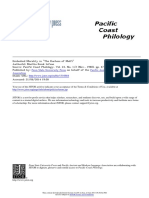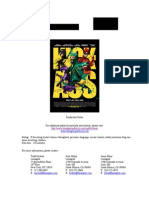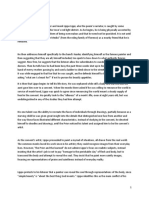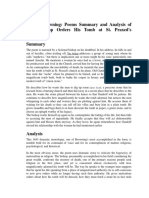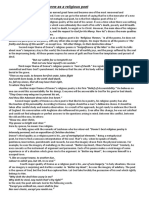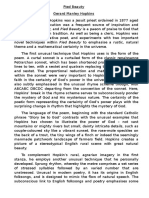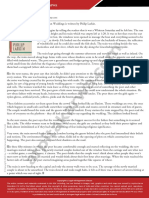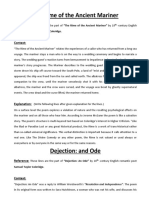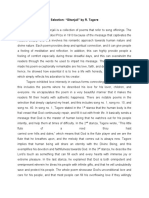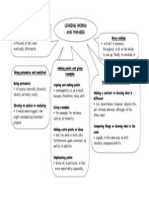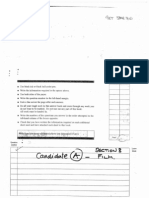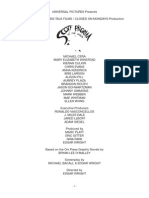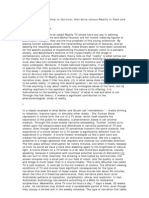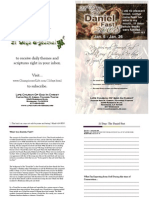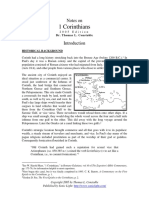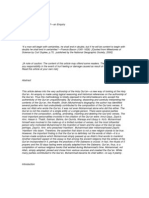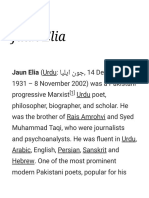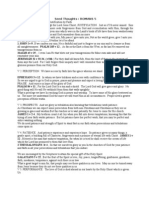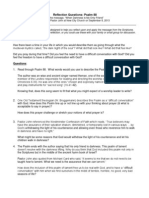Fra Lippo Lippi - Study Guide YR12 Lit
Fra Lippo Lippi - Study Guide YR12 Lit
Uploaded by
MrSmithLCCopyright:
Available Formats
Fra Lippo Lippi - Study Guide YR12 Lit
Fra Lippo Lippi - Study Guide YR12 Lit
Uploaded by
MrSmithLCOriginal Description:
Original Title
Copyright
Available Formats
Share this document
Did you find this document useful?
Is this content inappropriate?
Copyright:
Available Formats
Fra Lippo Lippi - Study Guide YR12 Lit
Fra Lippo Lippi - Study Guide YR12 Lit
Uploaded by
MrSmithLCCopyright:
Available Formats
Fra Lippo Lippi Study Guide
Contained within is an assortment of your responses. Ive tried where possible to include everyones work BUT in some cases this has not been possible. No one answered question 9 to a satisfactory standard.
What do we learn about the character and situation of Fra Lippo Lippi from the opening scene? Is he comfortable in his life as a religious painter? What irony in the fact that he must paint St. Jerome? How does his choice of words reflect his personality? In the opening scene we are introduced to Fra Lippo Lippis, he reveals his story to us in linear chronology as he recounts his childhood and his acceptance into the church. We get the impression he is drunk as he begins to use offensive language, zooks as well as bursting into song at every opportunity. His choice of words and his behavior seems out of place for a monk and may suggest that he is an arrogant man who thinks he can show off in any way. The reason for this arrogance becomes clear as we read on throughout the dramatic monologue. Despite the watch having their fingers firmly around his throat, he speaks with a degree of irreverence and even mocks his captors. We learn the reason for his arrest is that he is out late at night, (tis past midnight) having escaped from his bedroom and then chased 3 young women down the street, this further gives the impression that Fra Lippo does not take his monastic duties seriously and does not abide by the rules. One of the reasons for Fra Lippo Lippis arrogant character, stems from the fact he is employed by cosimo of the Medici, he says this like he is proud to be working for the very powerful, family and I think he isnt worried about the watch (police) because the most powerful people in the area are on his side. I think that Fra Lippo Lippi is not happy as a religious painter, a-painting for the great man, saint, saints and saints again. I could not paint all night Browning uses this alliteration to make it seem like there is more saints than usual and that the task of painting them is laborious. It is as if Lippi can see in front of him is his paintings of the religious saint. It gives us the image of Lippi becoming bored with his one main interest in life he seems to yearn to paint something more. 2. Why do you think Browning chose this scene as the poems introduction? Are there ways in which this scene constitutes an allegory of Lippis life situation? What are some effects of setting the poem in the renaissance Florence? In my personal opinion I think Robert browning chose this scene as the poems introduction because it introduces the kind of character Fra lippo Lippi is. It tells us he is an arrogant, selfish and a terrible monk. The opening scene of Fra Lippo Lippi could be an allegory for the rest of his life, Lippi is first found in an alley way, and here you catch me at an alleys end the alley way could show a setting for his younger life also. As an alley way is isolated and dark, Lippis life has been dull as he was an orphan and his auntie gave him up to be a monk because she didnt want him. His life is also isolated as he has
always been put in his own place as the Church restrict his painting and prevent him from truly expressing himself, so he has been isolated and alone. Setting the poem in the renaissance Florence shows a wealthy lifestyle as well as a focus on the arts. It is interesting that Fra Lippo Lippi is now living in a period of both great wealth and art as he himself has come from very humble beginnings and despite working for a rich banking family he is denied access to this wealth and is prevented from creating great art. Its interesting that Browning has set the monologue in the renaissance period, as this is a time when religion played a key role in daily life. It is ironic that the monks and the prior were so keen to have Lippi paint the religious messages as Lippi didnt want to paint in this style as he felt it did not truly represent the beauty of Gods creations. 3. What are Fra Lippo Lippis successive defences of his un-monastic behaviour? Which ones do you find most compelling? Fra lippo Lippi has constant un-monastic behaviour from the start of the dramatic monologue. He tells us his personal life story and holds nothing back via his case building story of how he came to join the monastary. In the opening Fra lippo Lippi tells us he works for the Medici family, cosmos of the Medici this makes us initially believe that he doesnt care about his unmonastic behaviour as he has power through working with the powerful family. This is compelling as it draws attention to the fact he wants everyone to know he is in league with the Medici family so it shows him being proud. Lippi later trys to gain sympathy from the reader by telling us he is an orphan my mother died And father died they left me in the street. By doing this he is trying to back up reasons for why he is so bad, he explains how at a very young age he had to agree to give up women and wealth in order to join the monastery. The stories he tells of his time growing up with the monks recounts how they treated him with a mixture of kindness and cruelty until they discovered his ability to paint. They then sought to control his painting by preventing him creating images which bore any likeness to living people. 4. What kind of paintings had his monastic superiors wished him to paint, and how does his own art break this pattern? What is Lippis view of the proper subject matter and mode of art? What does he believe is its ultimate purpose? Fra Lippo Lippis monastic superiors had wished him to paint the figures of Christianity such as: Jesus Christ, God and the Virgin Mary, as they hold no sins unlike people. They can be painted with beauty as they were pure this beauty also provides enough of a difference between the common man and those who are God-like. His paintings did have to hold realistic likenesses but, at the same time, be something that does not exist. However Fra Lippo Lippi saw and appreciated the beauty in living beings, as God created them, he felt it was only fair to paint these things and truly represent the beauty in Gods work. An example of this would be the prostitute in the church, when he
presents his interpretation of her he is ordered to rub it out as she is too beautiful and then can only be conceived as sinful compared to the angelic portrait of her the devils game. Fra Lippo Lippis own opinion is that he should be able to paint what/how he wants to; this could cause his rebellion against the monasterys way of life as he sleeps with beautiful women-which could just be his own way of appreciating their beauty. He believes that if it goodness and innocence in front of him, he should be allowed to paint it the same, much like when he paints the people he sees in the church (lean, fat and a murderer) as these too are all Gods creation and help show the hypocrisy of the church, a institution which relies on the lean, fat and murder(ous) for its congregation yet refuses to acknowledge (through art) that they exist.
On line 137 it says Nay, quoth the Prior, turn him out, dye say? He recognises that Fra Lippo Lippi has great talent and asks him to paint the church walls. And Preaching Friars, to do our church up fine And he tells him to paint the truth And put the front on it that ought to be! So Fra Lippo Lippi paints fat and lean people and murderers. And the children admire these paintings, and the people dont like his drawings because they are too realistic and not religious. Shaking a fist at him with one fierce arm Lippis view of his art was the truth. He saw the world and the people in it, and the monks wanted him to paint the world so he did. But the monks wanted to see people with halos around their heads, and religious images. Fra Lippo Lippi believes that art was meant to show truth and be realistic with paintings. Frap Lippo believes the ultimate purpose of art, is to show a persons true form. He draws the lean person as lean, the fat person as fat and the murderer as a murderer. This is shunned by his superiors as they are not holy and pure like the bible characters, another way he gauges actual people, is by including the row of children and the man shaking his fist. This shows that his scene is real and provokes a response in the actual world and is confused as to why it cannot be presented in the form of a painting youve seen the worldthe beauty. He believe that all aspects of Gods creations should be admired and accepted, Fra Lippo Lippi tried to show beauty in places where it could have been overlooked, to show that individuals are just as respectable as these figures of religion. 5. Does Lippi seem to make an association between his womanizing and his artistic appreciation of realist details? Fra Lippo Lippi discusses women as if they are art, commenting on their features rather than their personalities, but doesnt disrespect them as he also sees what a person is like on the inside the soul. The very way he describes the allure of the women outside of his window is musical a sweep of lutestrings, laughs and whifts of song shows that he recognises the appeal of
women and appreciates this. It creates an image of beauty and enchantment, suggesting that is he powerless against the pull of these women. The idea of denying human nature (to be attracted to the women) never kiss the girls baffles Fra Lippo Lippi as he thinks it strange to deny one of ones needs. By being told that he cannot do something only makes him want to persue it more, just like when he is told he will never become a great artist like brother Lorenzo, only increases his determination to relay his appreciation of realistic details.
6. What kind of progression organises the poem? What substitute for overt dramatic action? The progression of the poem is of the tale of the Fra Lippo Lippi and the tale of his life. The tale is not constant and often includes older archaic forms of swearing such as Zooks! this shows the drunken nature of Fra Lippo Lippi, this will explain the frequent breaks in the tale with dashes and enjambment to help clearly demonstrate it. The frequent breaks in the tale can also depict the areas in the narrative when Fra Lippo Lippi is feeling emotional about the story he is telling with slower and more constant speech, this is done to catch the readers attention as this is irregular when compared to the rest of the poem; one example for this idea is during line 80 85 when he is forced to tell the part of him entering the monastery and the loss of his parents and being left on the streets, starving On fig-skins, melon-parings, rinds and shucks, Refuse and rubbish. The tale of Fra Lippo Lippi is often interrupted by the movement and the speech of the watchmen who have apprehended the monk drunken in an alley. Although insulting the intelligence of the watchmen stating My stomach is as empty as your hat this meaning they cant think for themselves or have little mind.
7. What are some characteristics of the poem's diction (word choice) and rhythm? Can you find passages in which the language and rhythms shift in accordance with meaning? There is use of unusual diction in the line Zooks, whats to blame? you think you see a monk! as this deviates from the structure of the two lines above whilst keeping with the syllable count of 9 or 10 per line. This is because the rhythm of the line is broken up by the punctuation which changes the intonation of the line. Browning possibly uses it at this stage to introduce the monks incredulous tone. Another line in the stanza alters the pace of the
poem Do,-harry out as the punctuation interrupts the flow of the line. In the line Master-a Cosimo of the Medici the pace of the line is sped up and then slowed down to help to illustrate the initial confusion of the monks connections as well as emphasise the importance of the Medici family in the poem. The next drastic change in the rhythm and pace in the poem is in the song that the monk sings Flower o the broom, take away love, and our earth is a tomb! this is to give this section of the poem a melodic feel as well as express the monks anguish that he cannot paint the earth as he sees it. The poem also slows before the beginning of the monks story of how he became a monk as shown by the non fluency feature renounce but is particularly emphasised in I; this is important as it signals the end of the previous section of the monks tale and clearly shows that a new section is about to begin. The song is continued in line 110 to separate the story into sections as well as express the monks emotions All the latin I construe is amo I love! shows him gloating. Throughout the poem it becomes a pattern that non fluency features are used to quicken the pace of the poem which is always used to express the emotions of the monk and influence the mood of the poem to suit the case building style of a Browning dramatic monologue see, now-why. There is also a consistent pattern of the poem being slowed down to be later sped up to place the emphasis on what the monk has to say such as in niece Saint Lucy and then sped up again later on in goodbye; no lights, no lights! which illustrates the monks urgency by shortening the sentences and breaking the flow of the rhythm with commas as well as changing the intonation of the way the line is spoken which helps to add drama from the regularity that has gone before. 8. How does the final scene in which Lippi describes the painting he will donate embody the poem's plot and thematic tensions? Who is referred to in the phrase, "Iste perfecit opus"? Do you find this scene a satisfactory resolution for the problems raised by the poem?
He talks of painting the saints and religious figures Could saint John there draw this summarises the monks case building of his argument that he should be able to paint the world and human nature as he sees and experiences it rather than denying the world that God has created and demonstrates through his contradictory actions that this should also be true of human nature He made you and devised you suggests that people are as God intended otherwise he would have created them to be different. This is also contradicted by the other elements of human nature that are subtly hinted at throughout the poem such as the role of the Medici family and their reputation in the town munificent House that harbours me that suggests that people do not treat others as equals which is promoted by religion but instead hold power over others Hes Judas to a title as shown in the reaction to the mention of the Medici name You know them and they take you Iste perfecit opus is a direct reference from Bowning from the picture Coronation of the Virgin in which Fra Lippo Lippi features next to a scroll which translates as This man caused the work to be done but was misinterpreted by Browning as
to mean that Lippi had inserted a self portrait into the picture. The poem comes to a somewhat satisfactory end in that it is established that the monk does get to paint religious figures showing that the issue may have resolved slightly and that the monk gets to continue on his way after telling his story without any consequence suggesting that the case building nature of the story worked.
10. Does the author seem to believe that the moral qualities of an artist's life and work are related? There is evidence to suggest that the moral qualities of an artists life and work are indeed related as the monks behaviour as illustrated in the beginning of the poem goes against the morals and behaviour expected of a monk such as in the suggestion that he is drunk certain how dye call? shown by non fluency features as well as the fact that he visits prostitutes spotive ladies leave their doors ajar. This contradiction is mirrored upon the subject of art as shown later on in the poem in stanzas 290 and 295 as he feels that art is to be passed over, despised? Or dwelt upon, wondered at? however he is unable to do so as it offends people as they consider Gods creations to be sacred and cannot be duplicated in a painting as it is disrespectful Gods works-paint anyone, and count it a crime. He argues that the world around him is already complete nature is complete so it seems contradictory that he cannot paint it realistically even though it may be as God intended it to be Art was given for that. The behaviour of the monk and his inability to paint what is around him shows that he is denied his human nature by religion as he is not allowed to drink etc. but continues to do so but he cannot paint realistically in art as this would show the true nature of people. This is highlighted especially in stanza 145 where he paints good old gossips waiting to confess to a man fresh from his murder. This is particularly fitting with Brownings views as he believed that the Victorians had disillusioned themselves from the truth of human nature and instead strived to fit an ideal that may seem to be more approving in the eyes of religion which is the key message of Fra Lippo Lippi.
11. Did you like this poem? Which of its qualities did you find interesting? I personally enjoyed reading Fra Lippo Lippi because I felt it gave a true representation of life, through the story of a monk in a monastery. I believe that the setting of the monastery could be seen as a parallel to normal life as
we see it; because under the first impression we can believe that the monks are calm and without sin, but the story of Fra Lippo Lippi allows the reader from Brownings perspective to view the world as full of sin and temptation. We can view this from Fra Lippo Lippi, and see that even if we attempt to live a world without sin, in the style of Lippo Lippi, who is tempted by women who is seen as Flower o the thyme, drink, as he is found drunk, swearing Zooks and mocking the watchmen with Weke Weke. I particularly liked the hidden internal metaphors within the poem for the temptation and hidden world of the monks. One example for this is after Fra Lippo Lippi enters the monastery for the first time and is talking t0 a monk and is described by him as the good fat father Meaning the monks are seen as taking what they want, not what they need. On the other hand, I personally did not like the length of the poem and feel that the poem would be just as good if it was compacted down to 250 lines instead of the 393 lines. I also found the twisting tenses at times confusing as they are sometimes not clear to view, but after frequent reading, I discovered it was used for the effect of the drunken consciousness of Fra Lippo Lippi. In Conclusion, I enjoyed the poem, due to the hidden meanings that can only be explored through more knowledge of the poem and the context of the poem.
12. What views of religion does this poem seem to embody? To what extent would they have been shared by his Victorian audience? Religion often holds the idea of abstinence and restraint as being a way of becoming closer to God: to drink, swear and have sex, was seen as entirely unacceptable. But know that the Medici family protects Fra Lippo Lippi; he can do as he pleases without being penalised by society. People of God are meant to be pure and sinless; however the monks portrayed in Fra Lippo Lippi do not seem completely committed to serving the lord. This poem also seems to concern itself with the idea of idolised characters such as Jesus Christ and the Virgin Mary, as they were super humanly natural and beautiful because they were at one with God. They were often viewed a something to aspire to in Victorian society as they were obsessed with the image of the past being better than the (then) present. As they viewed themselves as scandalous and improper, they attempted to create a false exterior around society to hide the sins being committed. The creation of Lippis art can be seen as a metaphor for this, with the focus on the idealised surface rather than seeing the truth beneath, Lippis paintings showed no sinners not because they didnt exist but rather because he was forbidden to do so. Likewise the Victorians see only the beauty of the Renaissance era because they chose to look only at the art created rather than the society it came from. The views expressed by the monastic superiors might have been shared by his Victorian audience as it shows a respectable way of life and to dedicate
your life to the lord would be a great honour. It also displays a common ground of respect for your superiors/elders (no matter how corrupt they might be); which would be fondly looked upon by the Victorians as it is the type of behaviour they wished to promote. However the views expressed by Fra Lippo Lippi show a controversial side of society, a man of God should not be getting drunk and sleeping with women. This also reflects the scandalous side of Victorian culture, the side they were trying to withdraw from prying eyes. By doing so Browning is mocking his peers, as they believe that the past was a much purer time and is something to mold modern (Victorian) society on. Fra Lippo Lippi shows a side to religious followers that the public could not imagine or come to terms with, which could have forced them to reconsider the ideas that they were basing their lives on, thus obligating them to reevaluate their own society and way of life
You might also like
- Strongman Is His Name, What Is His Game by Drs Jerry & Carol Robeson-129pgDocument179 pagesStrongman Is His Name, What Is His Game by Drs Jerry & Carol Robeson-129pgAida Mohammed94% (34)
- 40 Days Prayers and Devotions On Earth's Final Events (Dennis Smith (Smith, Dennis) )Document152 pages40 Days Prayers and Devotions On Earth's Final Events (Dennis Smith (Smith, Dennis) )EMMANUEL WONTUMI-AMOAH100% (3)
- Folk Tales of The MaldivesDocument337 pagesFolk Tales of The MaldivesHammadh100% (1)
- Duchess of Malfi - Moral VisionDocument14 pagesDuchess of Malfi - Moral VisionArghya Chakraborty100% (1)
- William WordsworthDocument21 pagesWilliam WordsworthAnkit AnandNo ratings yet
- PreludeDocument8 pagesPreludeKristi CooperNo ratings yet
- Kick Ass Production NotesDocument45 pagesKick Ass Production NotesMrSmithLCNo ratings yet
- Fra Lippo Critical Notes 2Document19 pagesFra Lippo Critical Notes 2Bipasha SenNo ratings yet
- Fra Lippo LippiDocument4 pagesFra Lippo LippiAnonymous SY1kBzuNo ratings yet
- Dramatic Monologue Filippo Lippi Church Blank Verse Iambic PentameterDocument2 pagesDramatic Monologue Filippo Lippi Church Blank Verse Iambic PentameterEsther BuhrilNo ratings yet
- Fra Lippo LippiDocument6 pagesFra Lippo LippiKrishnaNo ratings yet
- Robert Browning: Poems Summary and Analysis of "The Bishop Orders His Tomb at St. Praxed's Church"Document3 pagesRobert Browning: Poems Summary and Analysis of "The Bishop Orders His Tomb at St. Praxed's Church"Gaurav KumarNo ratings yet
- The Canonization by John Donne Essay Example For FreeDocument4 pagesThe Canonization by John Donne Essay Example For Freepriya royNo ratings yet
- 09 Shelley Defence of PoetryDocument5 pages09 Shelley Defence of PoetrysujayreddNo ratings yet
- Affliction (I) AnalysisDocument2 pagesAffliction (I) AnalysisSTANLEY RAYENNo ratings yet
- John DonneDocument5 pagesJohn Donneabc def100% (1)
- HopkinsDocument9 pagesHopkinssazzad hossainNo ratings yet
- Character AnalysisDocument6 pagesCharacter AnalysisChan Zaib Cheema100% (1)
- SENSUOUS AND SCHOLARLY READING IN KEATS'S ON FIRST LOOKING INTO CHAPMAN'S HOMER' / Thomas DayDocument8 pagesSENSUOUS AND SCHOLARLY READING IN KEATS'S ON FIRST LOOKING INTO CHAPMAN'S HOMER' / Thomas DayraimondisergioNo ratings yet
- Assignment 6 Acres and A ThirdDocument7 pagesAssignment 6 Acres and A ThirdTejaNo ratings yet
- John DonneDocument5 pagesJohn Donneabc defNo ratings yet
- An Essay On Man Epistle IDocument3 pagesAn Essay On Man Epistle IAnonymous SY1kBzuNo ratings yet
- Pied BeautyDocument2 pagesPied BeautyHamish FarquharsonNo ratings yet
- Why The Novel MattersDocument2 pagesWhy The Novel MattersTasnim Azam MoumiNo ratings yet
- Shooting An ElephantDocument3 pagesShooting An Elephantatapp1100% (1)
- Background:: The Way of The World Is A Stage Play in The Form of A Comedy of Manners, WhichDocument6 pagesBackground:: The Way of The World Is A Stage Play in The Form of A Comedy of Manners, WhichMohammad Ekramul Islam Khan (182013005)No ratings yet
- "Locksley Hall": Alfred Lord TennysonDocument5 pages"Locksley Hall": Alfred Lord TennysonAhkham Hossain ShaanNo ratings yet
- Analysis of The Definition of Love by Andrew MarvellDocument10 pagesAnalysis of The Definition of Love by Andrew MarvellMd Tazbir0% (1)
- Prayer Before Birth Analysis: Stanza OneDocument8 pagesPrayer Before Birth Analysis: Stanza OneshettyNo ratings yet
- BequestDocument5 pagesBequestddbddb149No ratings yet
- Sons and Lovers Book ReviewDocument2 pagesSons and Lovers Book ReviewRinzen Horizon0% (1)
- Savitri Book 1 Canto 1 Post 5Document3 pagesSavitri Book 1 Canto 1 Post 5api-3740764No ratings yet
- Three YearsDocument48 pagesThree Yearsiola90No ratings yet
- Ode To PsycheDocument7 pagesOde To PsychelucienneNo ratings yet
- Enterprise by Nissim EzekielDocument5 pagesEnterprise by Nissim EzekielAarti VasanNo ratings yet
- 073 Whitsun WeddingDocument1 page073 Whitsun WeddingDebmita Kar PoddarNo ratings yet
- English Literature Essays - Proviso Scene of - The Way of The WorldDocument2 pagesEnglish Literature Essays - Proviso Scene of - The Way of The WorldZeeshan LiquatNo ratings yet
- As You Like ItDocument37 pagesAs You Like Itdark nightNo ratings yet
- Context ST ColeridgeDocument3 pagesContext ST ColeridgeIrfan Raza100% (1)
- Musee Des Beaux Arts Final PaperDocument6 pagesMusee Des Beaux Arts Final Paperapi-527753673No ratings yet
- LiteratureDocument2 pagesLiteratureAnamika Rai PandeyNo ratings yet
- Shelley's Adonais - A Fryean Archetypal Perspective PDFDocument9 pagesShelley's Adonais - A Fryean Archetypal Perspective PDFLab WhisperNo ratings yet
- Jimmy PorterDocument11 pagesJimmy PorterKeerthi AjayNo ratings yet
- What Kind of A Poem Is Matthew ArnoldDocument26 pagesWhat Kind of A Poem Is Matthew ArnoldDilip ModiNo ratings yet
- Traditional Symbolism in Kubla KhannDocument5 pagesTraditional Symbolism in Kubla KhannMelanie HadzegaNo ratings yet
- Wordsworth's Attitude To Nature and Man As Revealed in Tintern AbbeyDocument2 pagesWordsworth's Attitude To Nature and Man As Revealed in Tintern AbbeyAly FahadNo ratings yet
- Selection: "Gitanjali" by R. TagoreDocument2 pagesSelection: "Gitanjali" by R. TagoreKamille PobleteNo ratings yet
- Escapism in Romantic Poetry and Conventional PoetryDocument8 pagesEscapism in Romantic Poetry and Conventional PoetryHania Eng21No ratings yet
- Element of Self-Reflection in The Essays of Charles LambDocument4 pagesElement of Self-Reflection in The Essays of Charles LambDr. GEORGE KOLANCHERYNo ratings yet
- Of TRUTH by Sir Francis BaconDocument4 pagesOf TRUTH by Sir Francis BaconHoor AinNo ratings yet
- AgeDocument3 pagesAgekirtiarora1412No ratings yet
- Essay Sonnet 65-RevisedDocument6 pagesEssay Sonnet 65-Revisedapi-350031340100% (1)
- The Poem - VirtueDocument6 pagesThe Poem - VirtueTapi SkNo ratings yet
- Infant Joy Infant SorrowDocument4 pagesInfant Joy Infant SorrowCecilia Garfias100% (1)
- Browning's Self - Revealing DukeDocument3 pagesBrowning's Self - Revealing DukeYahia Al-NaggarNo ratings yet
- OzymandiasDocument2 pagesOzymandiasGokul RamachandiranNo ratings yet
- CANDIDA Eugene MarchbnksDocument1 pageCANDIDA Eugene Marchbnksmithu11No ratings yet
- Browing Dramatic MonolgueDocument3 pagesBrowing Dramatic MonolgueJaved Gunjial100% (1)
- Tintern Abbey 4023Document2 pagesTintern Abbey 40234023 Radhika Mohan PandeyNo ratings yet
- Key Facts About Wuthering HeightsDocument5 pagesKey Facts About Wuthering HeightsTamojoy BrahmaNo ratings yet
- Bliss - AnalysisDocument7 pagesBliss - AnalysismaryamerrafyqNo ratings yet
- AreopagiticaDocument3 pagesAreopagiticaAna Maria DospinescuNo ratings yet
- Study Guide to The Vicar of Wakefield by Oliver GoldsmithFrom EverandStudy Guide to The Vicar of Wakefield by Oliver GoldsmithNo ratings yet
- A2 Coursework Schedule 2015-2016Document5 pagesA2 Coursework Schedule 2015-2016MrSmithLCNo ratings yet
- Afl Cwork Yr12 2015Document9 pagesAfl Cwork Yr12 2015MrSmithLCNo ratings yet
- Linking Words For CADocument1 pageLinking Words For CAMrSmithLCNo ratings yet
- Hunger Games - Reaping Scene YR10Document18 pagesHunger Games - Reaping Scene YR10MrSmithLCNo ratings yet
- AFL Evaluating Peer Work: YR 12 Media AFL Activity PrintDocument9 pagesAFL Evaluating Peer Work: YR 12 Media AFL Activity PrintMrSmithLCNo ratings yet
- Connective Words To Improve PEEDocument1 pageConnective Words To Improve PEEMrSmithLCNo ratings yet
- Media Starter TuesdayDocument2 pagesMedia Starter TuesdayMrSmithLCNo ratings yet
- AFL Cwork YR12Document10 pagesAFL Cwork YR12MrSmithLCNo ratings yet
- Level 1 ExemplarDocument10 pagesLevel 1 ExemplarRFrearsonNo ratings yet
- Robert Browning AnnotationsDocument7 pagesRobert Browning AnnotationsMrSmithLCNo ratings yet
- 11H2 OMAM Essay PlansDocument23 pages11H2 OMAM Essay PlansMrSmithLCNo ratings yet
- Preparation For A2 Practical Project: Analysing Media Trailers KKSDocument8 pagesPreparation For A2 Practical Project: Analysing Media Trailers KKSMrSmithLCNo ratings yet
- Scott Pilgrim Vs The World NotesDocument48 pagesScott Pilgrim Vs The World NotesMrSmithLCNo ratings yet
- G324 Music Video InductionDocument10 pagesG324 Music Video InductionMrSmithLCNo ratings yet
- From The Truman Show To Survivor: Narrative Versus Reality in Fake and Real Reality TV by Marie-Laure RyanDocument13 pagesFrom The Truman Show To Survivor: Narrative Versus Reality in Fake and Real Reality TV by Marie-Laure RyanMrSmithLCNo ratings yet
- Zac Poonen Old Covenent Vs New CovenentDocument24 pagesZac Poonen Old Covenent Vs New CovenentashirwadmagazineNo ratings yet
- Daniel Fast Prayer JournalDocument8 pagesDaniel Fast Prayer JournalTara LonzoNo ratings yet
- 1 CorinthiansDocument203 pages1 CorinthiansKang Ha Neul100% (1)
- Who Authored The Qur'an-An EnquiryDocument68 pagesWho Authored The Qur'an-An EnquiryRAFSHAN100% (2)
- Rivers of Living WaterDocument84 pagesRivers of Living WaterJeric IsraelNo ratings yet
- Quran and Tafsir by ESCALANTEGULAMDocument14 pagesQuran and Tafsir by ESCALANTEGULAMHAULA BARA-ACALNo ratings yet
- Jewish Traditional Prayers: (Deuteronomy 6:5-9)Document4 pagesJewish Traditional Prayers: (Deuteronomy 6:5-9)GabrielNo ratings yet
- Amos 5, 18-20 Exegetical Theological PDFDocument14 pagesAmos 5, 18-20 Exegetical Theological PDFigdelacruz84No ratings yet
- Boon Church: Prayer Points Announcements of Oversea Chinese Mission October 19, 2014Document2 pagesBoon Church: Prayer Points Announcements of Oversea Chinese Mission October 19, 2014Anonymous jQItd9jtc0No ratings yet
- Updated June 2024 Rhapsody of RealitiesDocument80 pagesUpdated June 2024 Rhapsody of Realitiesigotech.bizz24No ratings yet
- Bible - The Living Word of GodDocument15 pagesBible - The Living Word of GodThe CCHNo ratings yet
- Nachman - StoriesDocument633 pagesNachman - StoriesAmir HampelNo ratings yet
- "There Is A Land of Corn and Wine": "I Am Thingking Today"Document3 pages"There Is A Land of Corn and Wine": "I Am Thingking Today"xyryzNo ratings yet
- Anger Dont Let It Destroy Your LifeDocument2 pagesAnger Dont Let It Destroy Your Lifelucifer_1261994No ratings yet
- Our Swamy10Document4 pagesOur Swamy10api-3758390No ratings yet
- TheEarlyChrchLttrsBodyChrist Excerpt PDFDocument33 pagesTheEarlyChrchLttrsBodyChrist Excerpt PDFkhetsiwe guleNo ratings yet
- Agate and TurqouiseDocument3 pagesAgate and Turqouiseshanua100% (2)
- Harnack and The Pfaff Fragments ReveiwDocument3 pagesHarnack and The Pfaff Fragments ReveiwMondlTNo ratings yet
- Archangels: Definition of An ArchangelDocument10 pagesArchangels: Definition of An ArchangelSurendar CpsNo ratings yet
- Jaun Elia - WikipediaDocument12 pagesJaun Elia - Wikipediamudassarhabib0% (1)
- 2065 5343 1 SM PDFDocument9 pages2065 5343 1 SM PDFPanca NingrumNo ratings yet
- Love Sex and Lasting Relationships - (Wake Up World! There's A Better Way To Do Relationships)Document4 pagesLove Sex and Lasting Relationships - (Wake Up World! There's A Better Way To Do Relationships)DoctorJ5100% (1)
- The Two SeedsDocument44 pagesThe Two SeedsJeffrey Hidalgo100% (2)
- Commentary On The Gospel of MatthewDocument533 pagesCommentary On The Gospel of MatthewDuncan Heaster100% (2)
- Justification by FaithDocument5 pagesJustification by Faithdi_fearnsNo ratings yet
- Chapter 13 DBLDocument21 pagesChapter 13 DBLAabirNo ratings yet
- Reflection Questions - When Darkness Is My Only Friend (Psalm 88)Document2 pagesReflection Questions - When Darkness Is My Only Friend (Psalm 88)NewCityChurchCalgaryNo ratings yet



